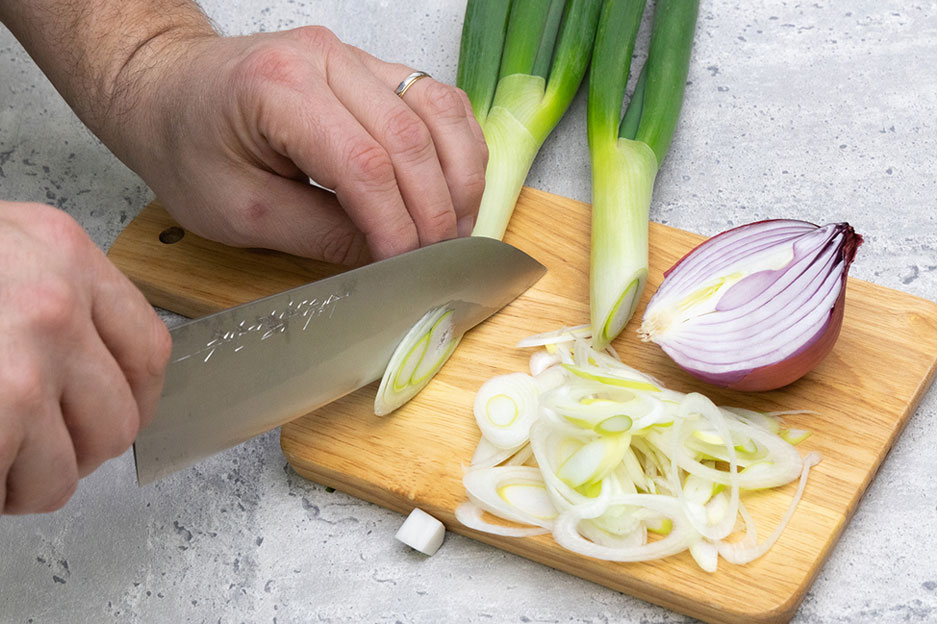It is said that the way products are cut before heat treatment depends on their taste in the finished dish.
For example, the degree of sweetness of carrots can vary depending on whether it is cut cubes or thin straw.
If you want to implement the recipe of the Japanese dish, you will also have to learn Japanese, even though there are analogues to most Japanese cutting methods in European cuisine.
Before starting work, remember that a good result can ensure the use of a quality knife. It is excellent if Japanese kitchen knives are in your arsenal - their shape and quality were especially thought out about the upcoming ways of cutting in Japanese, which we will now consider. A traditional Japanese vegetable knife, known as a Nakiri or Usuba, is ideal.
11 ways to cut vegetables in the Japanese way.
We list only the most well-known methods, as professional chefs distinguish more than 40 types of cutting vegetables.
1. Tanzakugiri ("Strip of Paper", cutting into broad stripes). First, vegetables (carrots or daikon) are cut into 4-5 cm long pieces. These pieces are then cut along to 1-1.5 cm wide plates. This operation is repeated several times. Good for salad and soup.
2. Hyoshigiri. This is an analogue of our cut with «bars». We start the same way as when we cut Tanzakugiri. The plates are then cut into 1-1.5 cm thick blocks. This method is used for cutting carrots and daikon. Good for stir fry and simmered dishes.
3. Sainomegiri (kakugiri) - cutting into «cubes». We cut 1-1.5 cm blocks, obtained in the previous paragraph, with an interval of 1.5 cm - we get familiar cubes. This method is used for cutting bamboo, potatoes, and carrots to prepare salads, side dishes and cooked dishes.
4. Sengiri ("Thousand", slicing in straws). Carrots or daikon are divided into parts 4-5 cm long and cut into thin plates. These plates are laid one on the other and cut with straw. For cutting long bow straws, take only the white part. The resulting onion straw is soaked. Sliced vegetables are used in many Japanese dishes, often for decoration. Also used for cabbage and ginger.
4. Mizingiri (fine slicing). First, the vegetables are cut with fine straw (Sengiri). Take, for example, the onion. It is cut in half and placed on the board down by a cut. Then the cuts are made with an interval of approximately 5 mm; the knife is turned horizontally, making the same cuts. To keep the onion from decaying, you can not cut it to the ground. Now, holding the sliced half of the bulb, we cut it finely from the edge.
To make the cut even finer, you need to press the end of the blade hand and chop the vegetable, moving the knife handle up and down. Finely chopped onions are used in the preparation of such dishes as rice with chicken, spaghetti, and curry sauce.
5. Kogutigiti ("Round") - a thin cut of vegetables across the fibres. This name refers to cutting the longbow from the end of the feathers; the onion is served as a seasoning for noodles. Cutting the same way, cucumbers are called Ushuaia. For carrots, use the name wagering. Most often used when cooking fried dishes.
6. Sasagaki ("Bamboo Leaf"). This method is used to cut carrots and Gobo (burdock). After preliminary cleaning, Gobo takes in the left hand, and the right-hand makes «shavings», and the root is rotated at this time, as when sharpening a pencil. The resulting chips fall into the dishes filled with water. Used to prepare the first dishes.
7. Men-tori. In the process of long cooking, sharp angles may break in thickly cut vegetables. To avoid this, the corners of sliced carrots and daikon are smoothed - cut in advance. Of course, this method is used mainly to prepare festive dishes.
8. Kakushibotyo («hidden knife»). To make thickly cut vegetables faster and better cooked, cruciform incisions are made on one side of the circle, and when served, they lay them down. This method is used in cooking, for example, meat stewed with vegetables.
9. Usugiri ("Thin" Cut). It's used to preserve a crisp texture of the product, such as cucumber, onion and Negi (green onion), eggplant, ginger, and garlic. Good for simmered dishes, stir fry, pickled dishes and salads.
10. Rangiri ("Random Shape"). It's when you rotate and cut the vegetable. The shape of the pieces will be random, but the size remains the same. It's resulted in more surface, so it makes cooking faster and absorbs more seasonings. Cut diagonally, rotating the vegetable by a quarter between the cuts. The method is good for digested dishes and stewed meat. Used for long-rounded vegetables like cucumber, carrot, daikon, eggplant or lotus root.
11. Hangetsugiri ("Half Moon"). The shape of the pieces will be a semi-circle. Cut the vegetable in half along the length and slice across. Used for cylindrical vegetables like cucumber, tomato, daikon, eggplant, carrot or lotus root. Good for simmered dishes and soups.
Cutting technique in detail
Use only well-sharpened knives to easily reach the desired shape and thickness of the cut without applying much effort. A sharp knife also allows you to make the cut more smooth. But using a blunt knife when cutting onions will make you «cry». It is believed that the best quality has a forged knife. For a long time, the knife of ceramics can maintain sharpness.
In conclusion, cutting vegetables in the Japanese way requires precision, patience, and practice. Following these steps, you can master this technique and impress your guests with beautifully presented dishes.



POST COMMENTS
0 COMMENT(S)